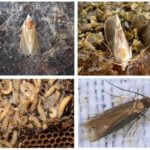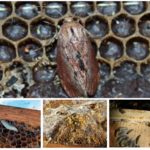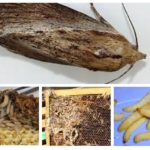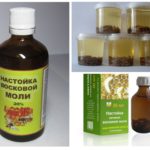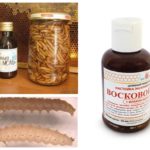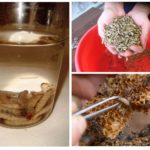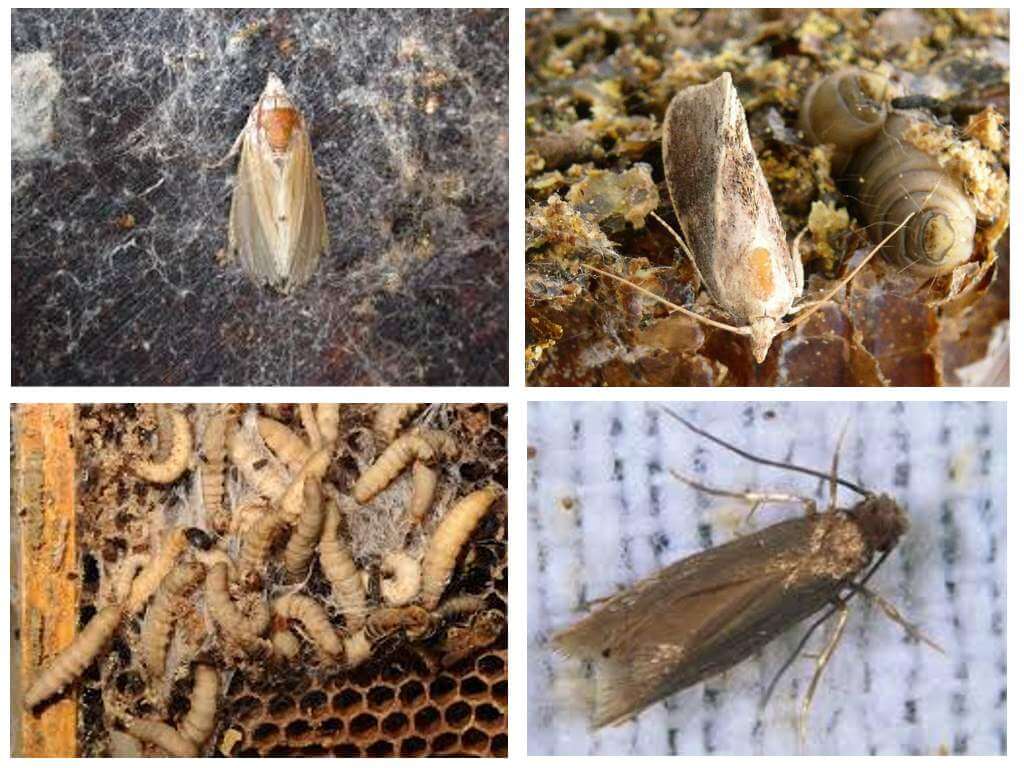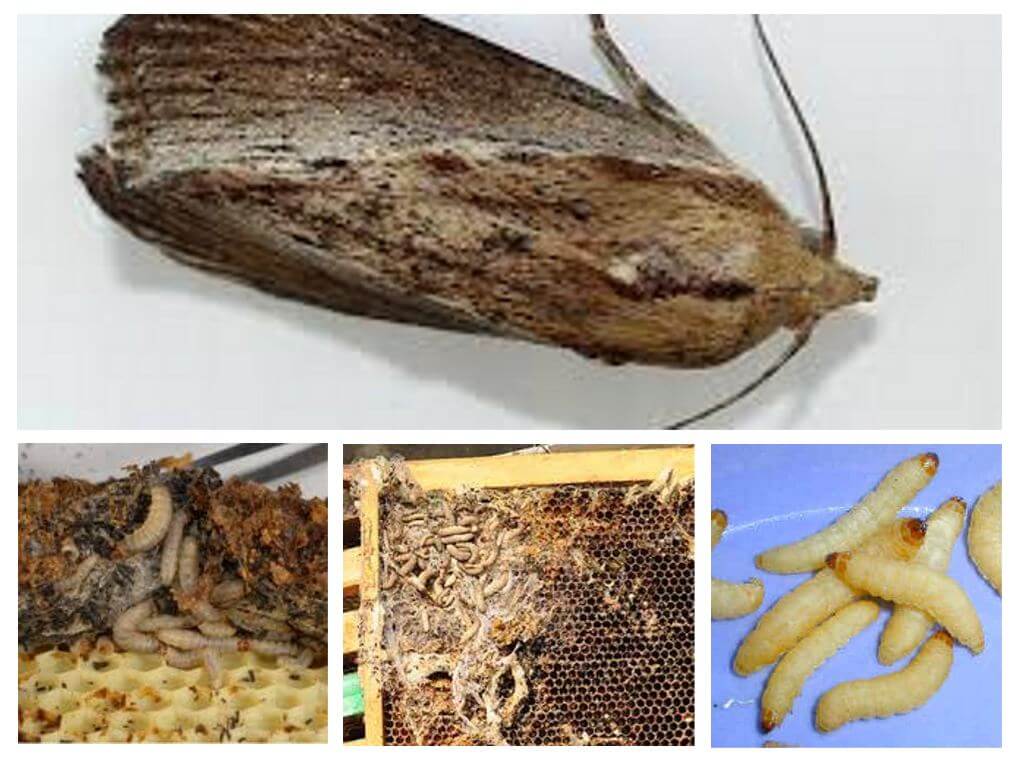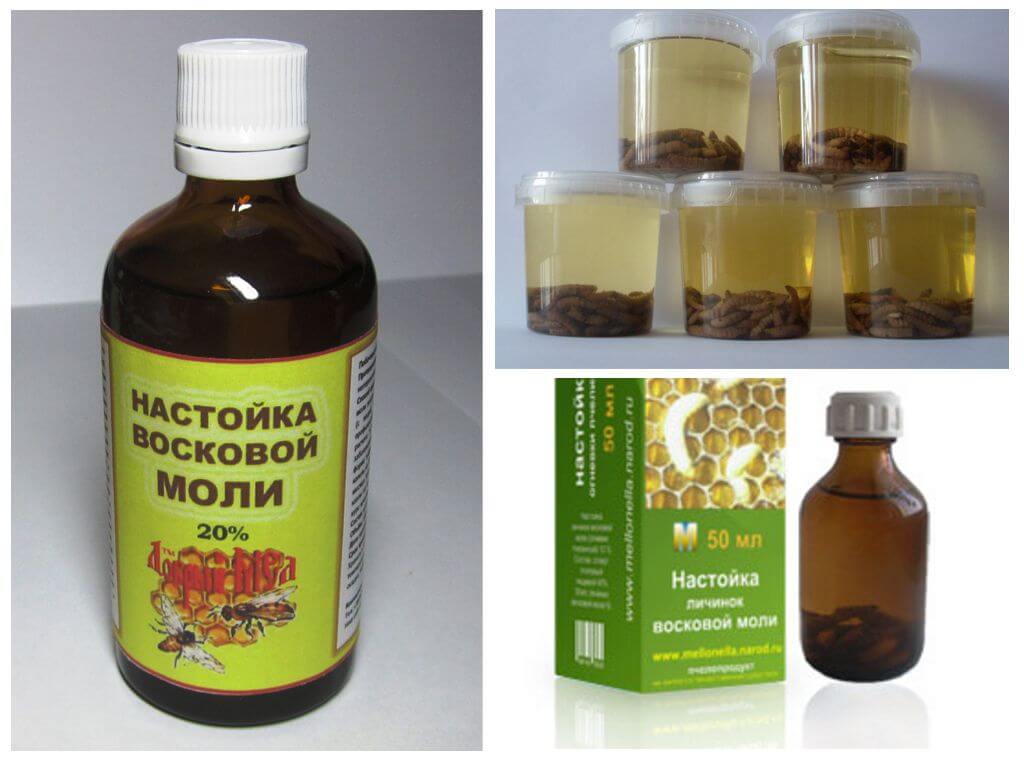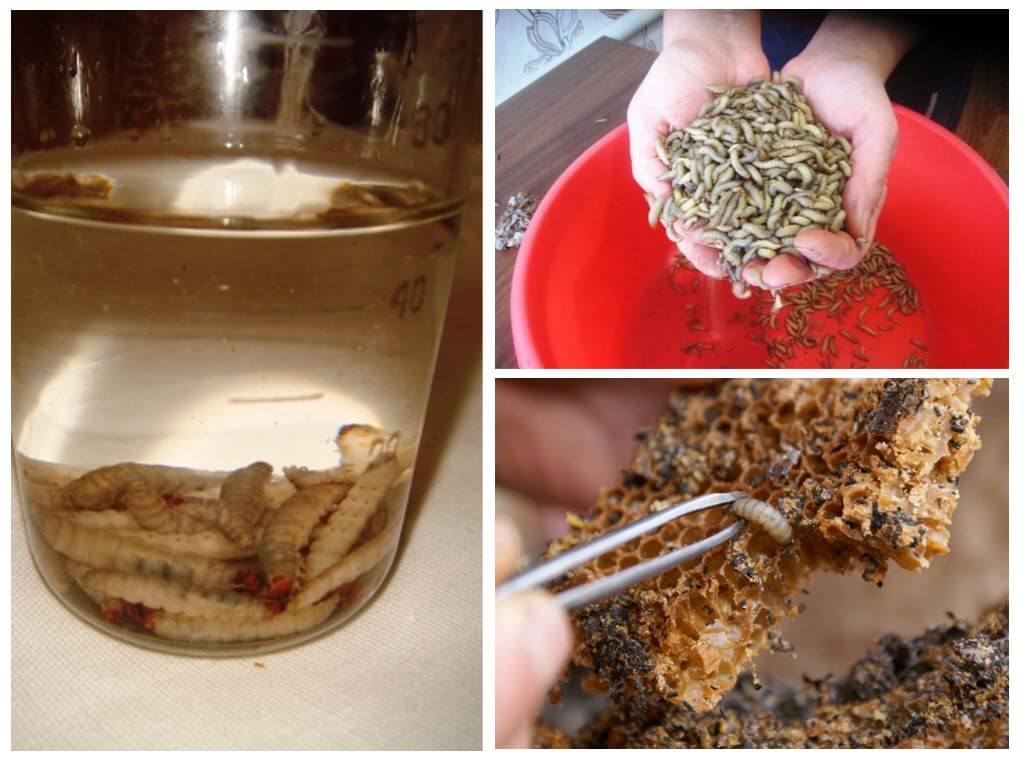Wax moth - application in traditional medicine
Content
- Wax moth
- Wax moth
- Wax moth
- Tincture of wax moth larvae
- Tincture of wax moth larvae
- Preparation of tincture
Insect life cycle
Wax moths are two types of butterflies that belong to the family of these moths - a large wax moth and a small bee moth or moth. Both species are pests apiaries. This kind of moth found in the apiary.
The butterfly of a large bee-eater flames has a wingspan of 2-3 cm. The front pair of wings is grayish-brown with dark spots and a fringed edge. Hind wings slightly lighter. The patronizing coloring of the moth's wings allows it to remain invisible on the bark of the trees, since the mating process takes place outside the hive. There the females return to lay their eggs.
After 5-8 days, the larvae of the wax moth emerge from the egg laying. The length of the juvenile is only 1 mm. The size of an adult individual is 1.8 cm. The larvae of the wax moth have a well-developed oral apparatus; they feed on the products detected by bees — honey, perga, and later on wax. During the growing season larva moth can damage about 500 cells cells. When the larvae of the wax moth are highly populated in the hive, they can eat brood, causing irreparable harm to the bee colony.
Beekeepers lead fighting butterflies wax moth in the hive, as one pest is able to give 2 to 4 generations of offspring. The larva of the wax moth eats more than 0.4 g of wax for the entire period of its life, which causes massive damage during mass settlement.
Interesting!
Immediately after leaving the cocoon, the larvae are able to move actively and even crawl into another hive, overcoming up to 50 m per day. The larva gnaws out the strokes in the wax cells, tightening the outer holes with threads. They do not allow the bees to get to the pest.
A month later, the larvae migrate from the honeycomb and attach themselves to the walls of the hive with thin silk threads. In the cracks and other shelters, they turn into pupae.
Scientific research of preparations from the large wax moth
Despite the fact that official medicine does not recognize the benefits of the wax moth in the treatment of about 100 pathologies, scientific studies are being conducted that confirm the therapeutic value wax moth drugs. Studies were conducted not only by I. Mechnikov, but also by many domestic and foreign scientists. What is wax moth and how it is useful, you can learn from the works of S.A. Mukhina. At the Institute of Biophysics of the Academy of Sciences of the USSR, as a result of clinical studies of the wax moth, its useful properties were confirmed in restoring damaged tissues of various organs. The problem of treating tuberculosis with the help of a wax moth medication has been studied by Russian scientists, professors A. Bogomolets and S.I. Metalnikov, Sinitsyn N.P. and others. Wax moth interested and foreign scientists. Her study deals with the Institute of Phytopathology and Applied Zoology in Germany. Scientific research on the wax moth continues today in the Academic Institutes - Physical Chemistry and Electrochemistry. A.N. Frumkin, theoretical and experimental biophysics, Samara State University, etc.
Wax moths are tried to be diluted under artificial conditions on various nutrient substrates in order to obtain an extract from the larvae of the wax moth on an industrial scale and with lower costs.
Interesting!
Wax moth serves not only for the manufacture of alcohol extracts. Hemolymph is extracted from immunized and non-immunized larvae, which is also used to treat pathologies.
The benefits of the wax moth are evidenced by its centuries-old use in traditional medicine. Honey moth known since the times of ancient civilizations. Constant interest in the biogenic stimulator indicates its effectiveness and ability to help in the treatment of severe pathologies.
Bioactive substances and their properties
The therapeutic properties of the wax moth extract are due to the products that it absorbs in the larva phase. All about the wax moth can be found by examining the composition of the active ingredients. The following bioactive substances were isolated from the larvae:
- squirrels;
- peptides;
- acetylcholine and serotonin;
- serine protease;
- free amino acids;
- mono - and disaccharides;
- low molecular weight growth factor;
- low molecular weight aromatic compounds;
- carbohydrates;
- fatty acid;
- metal ions, etc.
The wax mole contains protein-peptide complexes that inhibit the growth of gram-negative bacteria. These complexes of various molecular weights are able to penetrate the cells of pathogenic microorganisms and inhibit the processes occurring in it. The wax mole inhibits the growth of hemolytic bacteria, some gram-positive microorganisms that cause toxic infections.
Interesting!
The wax moth larva cuticle contains chitin, chitosan and their derivatives. These substances are easier and more economical to extract from insects than from the shell of marine life.
All substances that make up the larvae have a therapeutic effect on the human body. Wax moth is a natural raw material for the production of medicines, which is biocompatible, safe and has no restrictions in use. Preparation of wax moth:
- has adaptogenic properties;
- enhances metabolism and energy exchange;
- has cardioprotective properties;
- optimizes the rheological composition of blood;
- increases micro and blood transport;
- normalizes blood glucose (lecithin);
- regulates lipid metabolism;
- has a lipolytic effect (methionine);
- regenerates tissues, stimulates the synthesis of elastin;
- prevents the formation of scar tissue (serine protease);
- normalizes blood pressure;
- has antibacterial, antimicrobial and antimycotic properties, etc.
Since beekeeping is developed in our country, the issue of industrial production of chitosan and chitin-melanin complex from the cuticle of the wax moth larvae is being considered. Large wax moth is more suitable for the preparation of medicines, as its larva is larger.
The use of the drug in traditional medicine
Due to the fact that drugs manufactured by the pharmaceutical industry have a side effect on the body, science turned to the search for alternative solutions in the field of medicine and biology. Studied means of traditional medicine - alcohol infusion of bee larvae larvae. It was found that the reception of the tincture is shown when:
- treatment in order to prevent viral, inflammatory and cold diseases (lysine, riboflavin);
- pathologies of the nervous system (stroke, Alzheimer's disease, neuritis, paralysis, dementia, cerebral hernia, etc.);
- diseases of the heart and blood vessels (myocardial infarction, hypertension, coronary heart disease, cardiomyopathy, angina, etc.);
- diseases of the respiratory system (pneumonia, pleurisy, asthma, tuberculosis, tracheitis, bronchitis, etc.);
- liver diseases (jaundice, hepatitis, cirrhosis, etc.);
- diseases of the pancreas (cancer, diabetes, pancreatitis);
- pathologies of the vascular system (varicose veins, thrombophlebitis, endarteritis obliterans);
- joint diseases (arthrosis, arthritis, bursitis);
- skin diseases (rosacea, eczema, trophic ulcers, demodicosis, skin cancer);
- gynecological pathologies (adnexitis, anemia, infertility, placental insufficiency, etc.).
Wax moth extract is used in gerontology as a means of rejuvenation, which can reduce the manifestation of age-related dystrophic and degenerative changes in the human body. Crushed dried larvae of the wax moth and tincture of them are used in cosmetology as a natural peeling and biostimulator for skin and hair. The wax moth is found in some anti-aging cosmetics.
Serine protease - an enzyme that contains wax moth larvae, helps to reduce keloid scars, restores the structure of any tissue. The use of tincture of the wax moth for the treatment of purulent wounds and abscesses, ulcers and healing of postoperative sutures is based on these properties of tincture and prevents the formation of scars and scars. Serine protease restores the heart muscle after a heart attack, brain tissue after a stroke and craniocerebral injuries, prevents the formation of adhesions and fibrous degeneration of lung tissue after pneumonia, pleurisy. The enzyme helps reduce cavities in tuberculosis.
Feedback
“All her adult life suffered from varicose veins, chronic bronchitis, hypertension. With age, things have deteriorated. After a working day, my legs swelled and hurt so much that I could not sleep at midnight. It began to ache the heart, the tides drove to a faint. When I went to the doctor, I heard: “What do you want? Age! ”But then a friend with enthusiasm told about a new folk remedy - a tincture of wax moth larvae. I decided to try, because it won't get any worse. After 2-3 months, all my sores began to bother me less. I went to the doctor.It turned out that the pressure is normal and the cardiogram is good. The doctor did not even believe the results, once again forced him to make an ECG. Now I drink the elixir with even more enthusiasm! ”
Tamara Ivanovna, Pskov
Wax moth is used to prepare athletes for competitions and restore the body after physical overload. The infusion is indicated after a serious illness, people engaged in mental and physical labor, the elderly and children as an adaptogenic, anabolic, anti-stress, immunomodulatory, tonic and tonic.
Wax moth extract relieves toxicosis in the first trimester of gestation.
Amino acids in the composition of the drug can protect the body from toxins and the effects of ionizing radiation, radiation.
Those who take the drug of larvae of bee fire, note improved memory, increased working capacity and endurance.
Proven benefit of the wax moth larvae extract for a growing baby. The medicine promotes growth, bone mineralization, and an increase in the body's defenses. In pediatrics, tincture is used to treat the effects of birth injuries and fetal anomalies.
In cardiology, the wax moth tincture is used to protect the myocardium from the toxic effects of cardiac drugs.
Feedback
“My husband had been suffering from tuberculosis and diabetes for 10 years. Suffered 2 operations on the lungs and removal of fragments 7 ribs. After chemotherapy, his health deteriorated. Doctors refused to treat - they discharged home with an open form and hemoptysis. After the second operation, they said that 1-2 years remained to live. Because of diabetes, the lungs "crawled" like a rotten rag. "Superfluous" nine years he gave the infusion of wax moth. She grew the larvae herself, in our small town it is impossible to find a ready tincture. And familiar beekeepers only spat when asking about the wax moth. So traditional medicine once again furnished the official one! ”
Elina Kharitonovna, Arzamas
Alcohol tincture of larvae is used in the treatment of tuberculosis. Enzymes that are involved in the digestion and wax are able to dissolve the protective shell of Koch sticks, as a result - it dies from the action of antibiotics and cells of the immune system.
The benefits of wax moths in andrology are that the drug is used to increase potency,libido and treatment of male infertility. In urology, the drug has a great benefit in the treatment of benign prostatic hyperplasia.
Important!
You can not replace the reception of traditional medicines on the tincture of the wax moth without the consent and recommendation of the attending physician.
Recipes for drugs
There are many options for making tincture of wax moth larvae. We give a recipe tested in research laboratories. To prepare the medication, adult larvae are taken before pupation. 100 g of larvae are placed into a dark dark-necked glass jar, and 450 ml of 40% rectified ethyl alcohol is poured. In a dark place at a temperature of 20-25 ° С the vessel was kept for 21 days with constant agitation until the substances were completely extracted. The resulting infusion was filtered through a paper filter. The resulting liquid is brownish-brown in color with a characteristic honey aroma, it should be stored at 4 ° C. Product properties are maintained for 1-3 years.
On the basis of the extract in folk medicine is prepared ointment. For this take:
- 30-40 ml of finished tincture;
- 200 g sea buckthorn oil;
- 200 g of comfrey oil;
- 50 g of propolis;
- 50 g natural yellow wax.
The vessel with the ingredients is placed in a water bath and brought to a uniform state with stirring. Ointment is used externally.
To study the properties of the insect in science used homogenized larvae of the wax moth.
Recommended Dose
Take the tincture of 15-20 drops to 0.5 cups of water half an hour before meals. The last drug intake is 3-4 hours before bedtime.
You need to start taking the extract with 2-3 drops. In the absence of allergic reactions to bee products, bring the dose to the recommended. Children give the drug at the rate of 1 drop-1 year of life. From the age of 14 you can give the tincture in the adult dosage. In various pathologies, the recommended dose of the drug is:
| Diagnosis | The number of drops per 10 kg of patient weight | Razor (per day) |
| Tuberculosis: | ||
| - without highlighting the sticks | 3 | 2-3 |
| - open form with the formation of cavities | 8 | 2-3 |
| Tachycardia, varicose veins, GB, IHD, myocarditis, angina, etc. | 3 | 1-2 |
| Osteochondrosis, bursitis, gout, sciatica | 3-5 | 2-3 |
| Bronchitis, pleurisy, pneumonia | 4 | 2-3 |
| ARI, ARVI, asthma | 2-3 | 1-2 |
| To prevent and improve immunity | 2-3 | 1-2 |
After a heart attack, a wax moth tincture is started from day 10 on the background of standard therapy with 4 drops per 10 kg of body weight.
Feedback
“I began to take the tincture of the larvae of the wax moth after I had read about its magical properties in one of the rooms. I want to confirm once again that the tincture is valid! Whatever the doctors say, this is not a self-suggestion, but a real help in old age. He stopped torturing cough, shortness of breath, pain in the pancreas and gall. I stopped dizzy, flashed "flies" before my eyes and disgustedly ringing in my ears. In the morning I get up vigorous and full of strength, I easily fall asleep in the evening. Girlfriends began to “podnachivat” that fly like a lover. Now she is no longer afraid to grow old, I believe that decrepitude can be avoided even at my age! ”
Maria Mikhailovna, Odessa
The course of treatment is 3 months, since the drug has cumulative properties. Then make a break in 2 weeks and repeat the course. Need to control the effectiveness of treatment. After each course you need to undergo a medical examination.
Tincture of the wax moth, even with prolonged use, does not cause habituation and the emergence of resistant microorganisms. Wax moth and its metabolic products are used to make dietary supplements.

